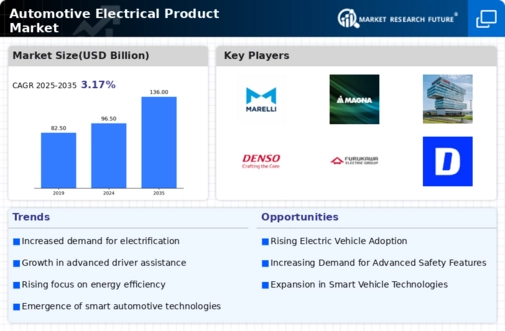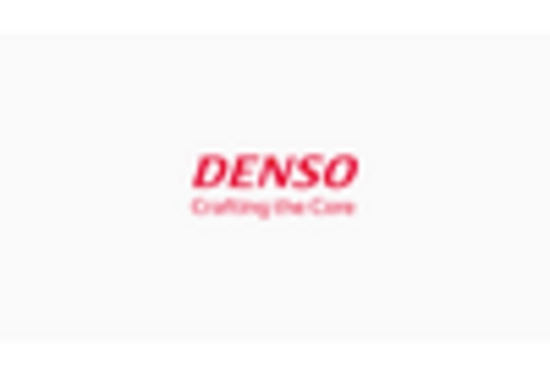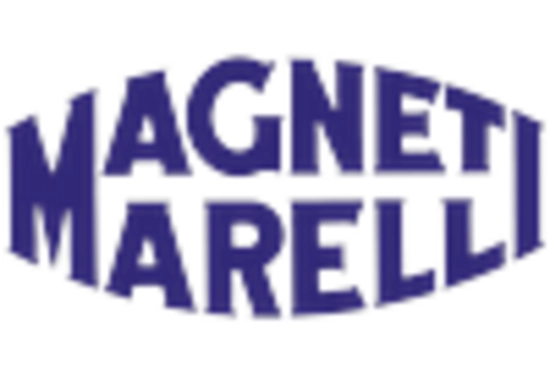Rising Demand for Electric Vehicles
The Automotive Electrical Product Market is experiencing a notable surge in demand for electric vehicles (EVs). This trend is driven by increasing consumer awareness regarding environmental sustainability and the need for reduced carbon emissions. As governments implement stricter regulations on emissions, the adoption of EVs is projected to rise significantly. According to recent data, the market for electric vehicles is expected to grow at a compound annual growth rate (CAGR) of over 20% in the coming years. This growth necessitates advanced automotive electrical products, such as high-capacity batteries and efficient charging systems, which are essential for the performance and reliability of EVs. Consequently, manufacturers in the Automotive Electrical Product Market are focusing on innovation and development to meet this escalating demand.
Growing Focus on Vehicle Safety Regulations
The Automotive Electrical Product Market is significantly impacted by the growing focus on vehicle safety regulations. Governments and regulatory bodies are increasingly mandating the incorporation of advanced safety features in vehicles, such as electronic stability control and automatic emergency braking systems. This regulatory push is driving the demand for high-quality automotive electrical products that ensure compliance with safety standards. Recent statistics indicate that The Automotive Electrical Product is expected to exceed USD 60 billion by 2025. As a result, manufacturers are compelled to innovate and enhance their product offerings to align with these regulations, thereby fostering growth within the Automotive Electrical Product Market.
Expansion of Automotive Aftermarket Services
The expansion of automotive aftermarket services is emerging as a significant driver for the Automotive Electrical Product Market. As vehicles age, the demand for replacement parts and upgrades increases, leading to a robust aftermarket sector. This sector is projected to grow substantially, with estimates suggesting it could reach USD 500 billion by 2027. The increasing complexity of automotive electrical systems necessitates high-quality replacement products, which presents opportunities for manufacturers within the Automotive Electrical Product Market. Additionally, the rise of e-commerce platforms is facilitating easier access to automotive electrical products, further propelling market growth. Manufacturers are thus adapting their strategies to cater to the evolving needs of the aftermarket, ensuring sustained growth in this segment.
Technological Advancements in Automotive Electronics
Technological advancements are profoundly influencing the Automotive Electrical Product Market. Innovations in automotive electronics, such as advanced driver-assistance systems (ADAS) and infotainment systems, are becoming increasingly prevalent. These technologies enhance vehicle performance, safety, and user experience, thereby driving demand for sophisticated electrical components. The market for automotive electronics is projected to reach approximately USD 300 billion by 2026, indicating a robust growth trajectory. As vehicles become more connected and automated, the need for reliable and efficient electrical products is paramount. Manufacturers are thus investing in research and development to create cutting-edge solutions that cater to the evolving needs of consumers and regulatory standards within the Automotive Electrical Product Market.
Increased Consumer Preference for Connectivity Features
Consumer preferences are shifting towards enhanced connectivity features in vehicles, which is a key driver for the Automotive Electrical Product Market. Features such as smartphone integration, real-time navigation, and vehicle-to-everything (V2X) communication are becoming essential for modern consumers. This trend is reflected in the increasing demand for automotive electrical products that support these functionalities. Market Research Future suggests that the connected car market is projected to grow at a CAGR of around 25% over the next few years. Consequently, manufacturers are focusing on developing innovative electrical solutions that facilitate seamless connectivity, thereby enhancing the overall driving experience and driving growth in the Automotive Electrical Product Market.

















Leave a Comment